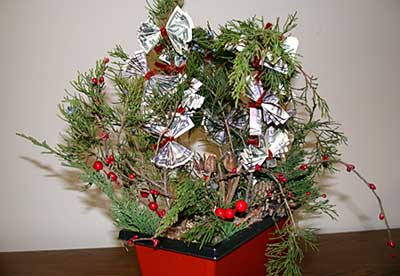7 January 2008 | Author: Jim Lovett
The monarch population in the eastern part of the breeding range was higher than normal for the second year in a row. Although the 2007 fall migration was smaller than normal in the upper mid-west, perhaps due to a mid to late season drought, the region was more productive than 2006. My expectation is that the overwintering population in Mexico will be 5-6 hectares* or a bit below the 5.9 and 6.9 hectares recorded the last two years, respectively.
Each year I predict the size of the overwintering monarch population in Mexico. My predictions are based on 15 years of experience, reports generated throughout the country, evidence of the success of our taggers, and a bit of intuition. In late September, in response to inquiries from the press, I estimated that the overwintering population in Mexico would be 7.5-8 hectares. I made this prediction before monarchs reached Texas and without consulting the population models I’ve been working on from time to time over the last several years. By mid October it became clear that this estimate was too high and I reduced the expectation to 5-6 hectares. The lower prediction is based on the sparse number of reports of large clusters of monarchs along the migration, a lower number of monarchs than expected (based on reports from observers) from the northeast as reflected in the Cape May counts and the apparent lateness of the migration from Kansas to the Mexican border.
In October I analyzed climatic data and overwintering numbers of monarchs for the last 14 years. This analysis showed that lower than expected numbers were measured at the overwintering sites following fall weather patterns similar to those seen this year. The population model I’ve developed is quite crude at the moment but it still may have some utility. The summer portion of the model predicts a winter population of 6 hectares for the winter of 2007-2008. However, the portion of the model that includes the fall conditions suggest a lower number will be measured when all the counting is done, perhaps around 5 hectares. The overall model is conservative and tends to not give the butterflies much credit for adapting to local conditions. So, while the fall data predicts a population of about 5 hectares, I’m expecting a number closer to 6 hectares. Let’s hope that both predictions are wrong and that my earlier seat of the pants estimate of 7.5-8 hectares was correct.
Last year, without using the model, I predicted that the overwintering population would be 6.5 hectares. The final tally, as measured by Eduardo Rendon and his crew from World Wildlife Fund Mexico (WWFMX), was 6.67 hectares. The total is a bit larger (6.9) if we include a small colony on Cerro Pelon (not measured by WWFMX) that was killed by a winter storm.
*NOTE: Monarchs are measured in hectares. Prior to 2002 we used estimates of 10-12 million monarchs per hectare based on earlier studies by Calvert and Brower. Surveys of the numbers of dead butterflies in two colonies following the winter storm that occurred in January of 2002, in which an estimated 80% of the monarch population died, produced strikingly different results (Brower, et al. 2004). Twenty-nine 0.05 square meter plots were sampled at each site, yielding an estimate of 2,680 monarchs per square meter at Zapatero (Sierra Chincua) and 7,253 monarchs per square meter at Conejos (El Rosario). This translates to 26,280,000 and 72,530,000 monarchs per hectare respectively. If we assume that these data represent only 80% of the monarchs that occupied each site, both numbers would be even higher. But, what can we do with these data? Technically, there are only two data points and they differ widely. We could use an average of the two, 49,400,000 or 61,750,000 if we assume 20% survived. However, we don’t know how evenly monarchs are distributed in the forests among all the overwintering sites. Are the high or low densities, as represented by theses two sites, the exception or the norm? We don’t know. Although it is clear that the number of monarchs is greater than 10-12 million per hectare, until we have more information on the tree and monarch densities at all sites, my preference is to measure monarch populations in hectares. Whatever the mean density, I’m able to make reasonably good predictions of the numbers of hectares of monarchs prior to the measures of the overwintering colonies.
Brower, L. P., Kust, D. R., Rendon-Salinas, E., Garcia-Serrano, E., Kust, K.R., Miller, J., Fernandez del Rey, C., and K. Pape. 2004. Catastrophic winter storm mortality of monarch butterflies in Mexico during January 2002. In The Monarch Butterfly: Biology and Conservation. Eds. Oberhauser, K. S. and M. J. Solensky. Cornell, Ithaca. pp151-166.
Filed under Monarch Population Status | 3 Comments »





